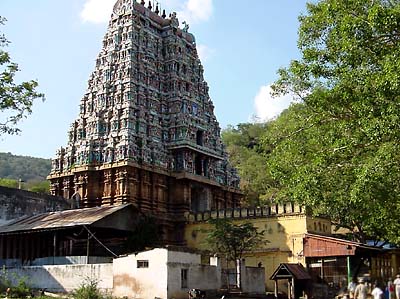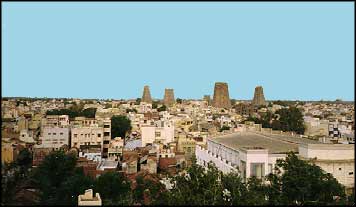|
|
MADURAI
 Madurai is an animated city packed with pilgrims,
beggars, businesspeople, bullock carts and legions of underemployed
rickshaw- wallahs. It is one of southern India’s oldest cities, and has
been a centre of learning and pilgrimage for centuries. Madurai’s main
attraction is the famous Sri Meenakshi Temple in the heart of the old
town, a riotously baroque example of Dravidian architecture with gopurams
covered from top to bottom in a breathless profusion of multicoloured
images of gods, goddesses, animals and mythical figures. The temple
seethes with activity from dawn till dusk, its many shrines attracting
pilgrims from every part of India and tourists from all over the world.
It’s been estimated that there are 10,000 visitors here on and one day! Madurai is an animated city packed with pilgrims,
beggars, businesspeople, bullock carts and legions of underemployed
rickshaw- wallahs. It is one of southern India’s oldest cities, and has
been a centre of learning and pilgrimage for centuries. Madurai’s main
attraction is the famous Sri Meenakshi Temple in the heart of the old
town, a riotously baroque example of Dravidian architecture with gopurams
covered from top to bottom in a breathless profusion of multicoloured
images of gods, goddesses, animals and mythical figures. The temple
seethes with activity from dawn till dusk, its many shrines attracting
pilgrims from every part of India and tourists from all over the world.
It’s been estimated that there are 10,000 visitors here on and one day!
Madurai resembles a
huge, continuous bazaar crammed with shops, street markets, temples,
pilgrims, choultries, hotels, restaurants and small industries. Although
one of the liveliest cities in the south, it’s small enough not to be
overwhelming and is very popular with travelers.
HISTORY
Madurai’s history can be divided into roughly four
periods, beginning over 2000 years ago when it was the capital of the
Pandyan kings. Then, in the 4th century BC, the city was known
to the Greeks via Magasthenes, their ambassador to the court of
Chandragupta Maurya. In the 10th century AD, Madurai was taken
by the Chola emperors. It remained in their hands until the Pandyas
briefly regained their independence in the 12th century, only
to lose it again in the 14th century to Muslim invaders under
Malik Kafur, a general in the service of the Delhi Sultanate. Here, Malik
Kafure established his own dynasty, which, in turn, was overthrown by the
Hindu Vijayanagar kings of Hampi. After the fall of Vijayanagar in 1565,
the Nayaks ruled Madurai until 1781 AD. During the reign of Tirumalai
Nayak (1623-55), the bulk of the Meenakshi Temple was built, and Madurai
became the cultural center of the Tamil people, playing an important role
in the development of the Tamil language.
Madurai then passed into the hands of the British East India
Company, which took over the revenues of the area after the wars of the
Carnatic in 1781. In 1840, the company razed the fort, which had
previously surrounded the city, and filled in the moat. Four broad
streets- the Veli streets –were constructed on top of this fill and
define the limits of the old city to this day.
Sri MEENAKSHI TEMPLE
Every day, the Meenakshi Temple attracts pilgrims in
their thousands from all over India. Its enormous gopurams, covered with
gaily-coloured statues, dominate the landscape and are visible from many
of the rooftops in Madurai. The temple is named after the daughter of a
Pandyan king who, according to legend, was born with three breasts. At the
time of her birth, the king was told that the extra breast would disappear
when she met the man she was to marry, and this duly happened when she met
Siva on Mt Kailasa. Siva told her to return to Madurai and, eight days
later, arrived there himself in the form of Lord Sundareshwara to marry
her.
Designed in 1560 by Vishwanatha Nayak, the present temple was
substantially built during the reign of Tirumalai Nayak (1623-55 AD), but
its history goes back 2000 years to the time when Madurai was the capital
of the Pandya kings. These are four entrances to the temple, which
occupies six hectares. It has 12 towers, ranging in height from 45 to
towers, the tallest of which is the 50-metre-high southern tower. The hall
of 1000 columns actually has 985.
Depending on the time of day, you can bargain for bangles,
spices or saris in the bazaar between the outer and inner eastern walls of
the temple, watch pilgrims bathing in the tanks, listen to temple music in
front of the Meenakshi Amman Shrine (the music is relayed through the
whole complex on a PA system), or wander through the interesting though
decidedly dilapidated museum.
This museum, known as the Temple
Art Museum, is housed in the 1000-pillared hall and contains some
beautiful stone and brass images, examples of ancient south Indian
scripts, friezes and various attempts to explain the Hindu pantheon and
the many legends associated with it, as well as one of the best exhibits
on Hindu deities anywhere. Unfortunately, many of the rebels are missing.
On most evening at 9 pm, temple music –mantras, fiddle, squeeze
box, tabla and bells – is played outside the Meenakshi Amman Shrine.
 TIRUMALAI NAYAK PALACE TIRUMALAI NAYAK PALACE
About 1.5km from the Meenakshi Temple, this Indo –Saracenic
palace was built in 1636 by the ruler whose name it bears. Much of it has
fallen into ruin, and the pleasure gardens and surrounding defensive wall
have disappeared. Today, only the entrance gate, main hall and dance hall
remain. The palace was partially restored by Lord Napier, the governor of
Madras, in 1866-72, and further restoration was carried out several years
ago.
There is a sound & light show (son et lumiere) in English,
daily at 6:45 pm, telling Madurai’s history using sound and coloured
lights and lighting is quite sophisticated.
You can get to the palace on a No 11,11A or 17 bus from the state
bus stand, or take the 20 –minute walk from the Meenakshi Temple through
an interesting bazaar area.
GANDHI MUSEUM
Housed in the old palace of the Rani Mangammal, this
oddly moving museum provides some little-known facts about the Mahatma,
although the only real piece of Gandhi memorabilia is the blood-stained dhoti from the assassination, displayed behind a bulletproof screen.
The museum also has an excellent History of India display with some fine
old photographs.
The local government museum is in the same grounds, as is a small
bookshops stocked with plenty of Gandhi reading matter.
MARIAMMAN TEPPAKKULAM TANK
This tank, five km east of the old city, covers and
area almost equal to that of the Meenakshi Temple and is the site of the
popular Tppam Festival. For most of the year, however, it is empty save
for local kids playing cricket in it. The tank was built by Tirumalai
Nayak in 1646 and is connected to the Vaigai River by underground
channels. The No 4 bus from the state bus stand stops at the tank.
OTHER ATTRACTIONS
A couple of temples outside Madurai may also be worth
a visit. The Tiruparankundram rock-
cut temple, eight km south of town, is one of the abodes of Sundareshwara
and can be reached by bus Nos4A, 5 and 32 Alagarkoil
Temple, 21 km north of Madurai, is a hilltop Vaishnavaite temple.
During the festival of Chithirai, a gold icon is carried in procession
from this temple to Madurai.
FESTIVALS
Madurai celebrates 11 big annual temple festivals
with only the monsoon month, called Ani
in Tamil, devoid of festivities. Check with the tourist office for
festival dates.
The principal event is Chithirai
(late April/early May), which celebrates the marriage of Sri
Meenakshi to Sundareshwara (Siva)
on the festival’s 10th day. The next morning, the deities are
wheeled around the Masi streets on huge chariots followed by thousands of
devotees.
Another festival which attracts pilgrims from all over India is the
12-day Teppam (Float) Festival held in January or early Meenakshi and
Sundareshwara are mounted on floats and taken to the Mariamman Teppakkulam
Tank. For several days, they are pulled back and forth across the water to
the island temple in the tank’s center, before being taken back to
Madurai.
PLACES TO STAY
TAJ GARDEN RETREAT, (Government Approved) Heritage
HOTEL MADURAI ASHOK, (Government Approved )3 Star
HOTEL INTERNATIONAL
HOTEL SUPREME
THINGS TO BUY
Madurai has long been a textile centre and the
streets around the temple still teem with cloth stalls and tailors’
shops. A great place to buy locally manufactured cottons as well as the
batiks loved by many travellers is Puthu Mandapam, an old, stone-pillared
hall just along from the eastern entrance to Sri Meenakshi Temple. Here
you’ll find lines of textile stalls opposite rows of tailors, each
busily treading away and capable of whipping up a good replica of whatever
you’re wearing in an hour or two. If you’re buying cloth to get
garments made up, it’s wise to know how much material you’ll need as
some merchants will talk you into buying way too much only to strike a
deal with the tailor who makes your clothes to keep the leftovers. The
owner of the Krishnamoorthy Cloth Store (stall No 108) is reliable and
gives fair prices for material. In addition, he the many street touts
who’ll offer to take you to their ‘brother’s shop’ at Puthu
Mandapam
|





